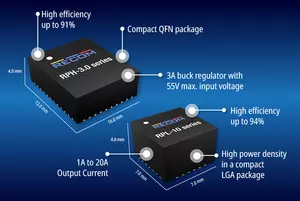New RPL and RPH Buck Converters Provide up to 20A
Apr 11, 2024

We have used our expertise in state-of-the-art circuit design and packaging techniques to push the boundaries of power density combined with cost-effectiveness and now offer new parts in the RPH and RPL series with ratings between 1A and 20A.
The RPL-1.0 operates over an input range of 3 to 22V with an adjustable output of 0.6 to 12V at 1A, comes in a compact 3 x 3mm LGA-M footprint, and is only 2mm tall. Depending on the input/output voltage combination, the part operates up to an ambient temperature of more than 80°C at full load, and up to 125°C ambient with derating. Efficiency is 84% typical at 5V in and 3.3V out.
The RPH-3.0 comes in a QFN package with a 10 x 12mm footprint and 4mm height and provides an adjustable output of 1 to 15V at 3A. The input range is 4.5 to 55V, and efficiency is up to 91%. Full output current is available at over 80°C at 12V input and 3.3V output, for example.
Part RPL-10 is feature-packed and is rated at 10A output. In an LGA-M package just 7 x 7mm, 4.4mm high, the input range is 4 to 16V, and the output is programmable between 0.6 and 5.5V. High efficiency of up to 94% allows operation at up to 90°C at full load depending on the input/output combination. Operating frequency can be selected between 600kHz and 800kHz, a pulse skipping mode maintains efficiency at light load, and constant on-time control can be selected for fast transient response.
The RPL-20, with its 20A rating, is in the same 7 x 7 x 4.4mm LGA-M package size as the RPL-10 and takes power density to a new level. Output is programmable from 0.6 to 5.5V, and the input range is 4 to 16V. Efficiency is as high as 94%, which enables operation at up to 90°C ambient at full load. Operating frequency can be set between 600kHz and 1MHz with pulse skipping and forced continuous conduction modes as selectable options.
All the new parts feature integrated magnetics and include a power good signal, remote on/off, and comprehensive protection against over-temperature, input under-voltage, output overload, and short circuits.
Applications for these ultra-compact parts include consumer, industrial, telecom, medical, or any end product where efficiency and power density are important.
The RPH-3.0 comes in a QFN package with a 10 x 12mm footprint and 4mm height and provides an adjustable output of 1 to 15V at 3A. The input range is 4.5 to 55V, and efficiency is up to 91%. Full output current is available at over 80°C at 12V input and 3.3V output, for example.
Part RPL-10 is feature-packed and is rated at 10A output. In an LGA-M package just 7 x 7mm, 4.4mm high, the input range is 4 to 16V, and the output is programmable between 0.6 and 5.5V. High efficiency of up to 94% allows operation at up to 90°C at full load depending on the input/output combination. Operating frequency can be selected between 600kHz and 800kHz, a pulse skipping mode maintains efficiency at light load, and constant on-time control can be selected for fast transient response.
The RPL-20, with its 20A rating, is in the same 7 x 7 x 4.4mm LGA-M package size as the RPL-10 and takes power density to a new level. Output is programmable from 0.6 to 5.5V, and the input range is 4 to 16V. Efficiency is as high as 94%, which enables operation at up to 90°C ambient at full load. Operating frequency can be set between 600kHz and 1MHz with pulse skipping and forced continuous conduction modes as selectable options.
All the new parts feature integrated magnetics and include a power good signal, remote on/off, and comprehensive protection against over-temperature, input under-voltage, output overload, and short circuits.
Applications for these ultra-compact parts include consumer, industrial, telecom, medical, or any end product where efficiency and power density are important.
| Series | |||||||
|---|---|---|---|---|---|---|---|
| 1 |

|
RPH-3.0
Focus
|
|
| |||
| 2 |

|
RPH-3.0-EVM-1
Focus
|
|
| |||
| 3 |

|
RPL-1.0
Focus
|
|
| |||
| 4 |

|
RPL-1.0-EVM-1
Focus
|
|
| |||
| 5 |

|
RPL-10
Focus
|
|
| |||
| 6 |

|
RPL-10-EVM-1
Focus
|
|
| |||
| 7 |

|
RPL-20
Focus
|
|
| |||
| 8 |

|
RPL-20-EVM-1
Focus
|
|
|
